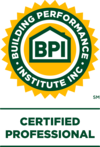One of the keys to performing a good energy audit is to be consistent. Consistency, yields high quality results for the homeowner. Having a sound routine and being sure to go through that routine for each and every house will serve the most seasoned home energy auditors very well.
One very nice experience as an auditor is to find things for people that are so easy to fix they could do it later in the afternoon after the audit is complete. And, for very little money. Each and every audit I make it a point to inquire with the homeowner about why they contacted us. Is it because of a specific problem you are experiencing? This helps me narrow some of my searching because it gives me good insights in to where to spend my time looking.
This leads my to a find I made at an audit Davidsonville, Maryland. For an auditor, it is a fairly common issue, although some of the time it is more hidden and less obvious and could be missed. On this day, the homeowner mentioned that one of the reasons they called is to figure out why the kitchen is so cold. They moved in last summer (June) and now it is January and the experience has prompted a call to figure out what is causing the problem.
 |
| Front of the home. |
As I began the audit and started outside to take a look around I began to get the overall picture of the house now that I was inside and did a full tour throughout. I made my way around the side of the house to the kitchen area.
Two things stand out to me right away. One thing to note there is that the kitchen is at the back corner of the house above the garage. The kitchen window above the sink is the window that can be seen in this photo above the garage door. The general area is inside the red lines.
The second thing that is is less obvious and is something that will require additional investigation is the exhaust hood just above the grill to the right of the sunroom.
For the most part, and of course this is something I mentioned to the homeowner, the problem is never only one thing. There usually are several things working against you and the ideas is to wrestle the power away from as many of those problems that you can in, order of how much they cost, in order to make the problem less of a problem.
So, treating the ceiling of the garage with a proper pressure boundary in addition to the thermal boundary would be a significant part of a project that was going to seriously attack the kitchen being cold. But, in this case the example that I will demonstrate here can be seen in all types of houses and perhaps this might be the only source to your issue.
Let's get back to the exhaust hood on the back, above the grill and next to the sunroom.
At first glance, it might just blend in and some might not even make the connection that it leads to the kitchen and those that do, may not make the connection that it is not connected. What I mean here is that if you turn the vent fan on above you range and if it is blowing air out at you then it is a recirculating fan. Why is this important?
Often times when a kitchen is remodeled little thought is given to the kitchen exhaust requirements. Many times the connection with the preexisting fan is not used. To further the trajedy of not reinstalling proper ventilation, nothing is done to seal and insulate the void leaving a large thermal bypass in a highly traveled area of the house.
Here are a few shots of the kitchen for some more perspective.
 |
Missing microwave/exhaust fan in the location of the outside vent hood.
The kitchen had exhaust at one time. |
Notice the area above the stove top. There is nothing there. Earlier I mentioned that the homeowner just purchased the house so this is the situation they inherited. The story for me was starting to take shape. The kitchen at one time had working exhaust and during the kitchen remodel it was eliminated, but the end result is a big offender when it comes to why the kitchen is not comfortable.
From the outside you can see that the depth of the exterior wall is roughly four inches and seeing the old wiring and the inside panel that this was a source of some of the problems in this kitchen. Thermal imaging confirmed it.
So keep this in mind if your kitchen is cold and drafty. It is possible this issue can exist if a microwave oven or range hood is in place with a new recirculating fan. The old exhaust hood is a gateway to the outside as seen in this example. A clue would be to look outside to see if there are any vent hoods not associated with any appliance.
 |
| This is a sample of a remodeled kitchen in an older home that has a recirculating microwave above the stove. |
So, how can you fix this yourself?
Here is how you do it. Find something solid, easy to cut to size and air tight. Sometimes heavy duty styrofoam furniture packaging will work. Another option is a piece of polyiso insulation foamboard from the hardware store, but check to see if you can find something around the house since you don't need much. Be sure to do the blocking part. You don't want to shoot a bunch of foam insulation in the hole and muck it all up in case you need it later or stuff fiberglass insulation in there because that will not work. Cut to size, place in the void and seal around the perimeter with spray foam. This will insulate and air seal at the same time and fix the thermal bypass in that location.














